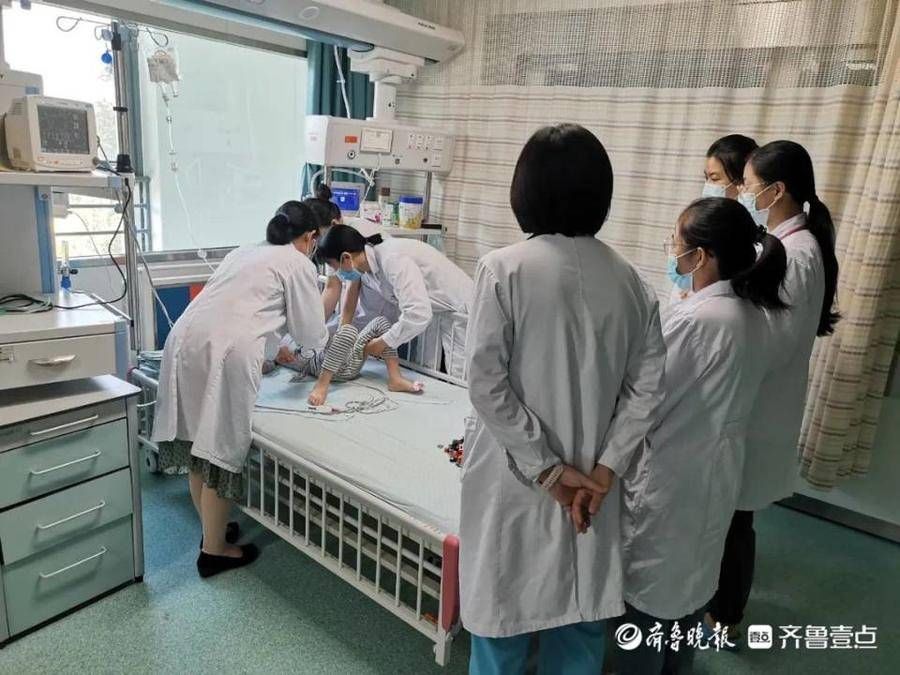Reporter Zhang Xiaoguang
Recently, Xiaobao (pseudonym), a 5-year-old boy, went to the Pediatrics Department of Zibo Central Hospital because of his yellow face and fatigue. The critical value was only 42g/L, and then he developed chest tightness, shortness of breath, nausea, cold sweats, and a slight cough, and his life was at stake.
Zibo Central Hospital’s Pediatrics Quick Organization Deputy Director Zhao Jie, Hematology Deputy Chief Physician Xue Ailing, attending physicians Jia Zhiyi and Wang Fengyu actively rescued them immediately. At the same time improve the examination to find the cause of anemia.
Zhao Jie introduced that there are various causes of anemia, and the etiological diagnosis is complicated. It is necessary to identify a variety of diseases. It is necessary to take bone marrow tests to exclude malignant blood system diseases such as leukemia and aplastic anemia. It is also necessary to determine whether there is hemolysis and whether There is nutritional anemia, whether there is iron deficiency, whether there is blood loss, etc.
After investigation, the child’s serum iron was extremely low, but ferritin was not low, which was inconsistent with general iron-deficiency anemia. After the condition was stabilized, lung CT examination showed that ground glass shadows were evenly distributed in both lungs. In addition, the child had symptoms of chest tightness, shortness of breath, and mild cough. The pediatric team highly suspected that the pulmonary hemorrhage was caused by pulmonary hemosiderosis. So far, the cause of anemia has been basically found, but it is still necessary to find hemosiderin cells in the sputum, gastric juice or bronchoalveolar lavage fluid of the child to make a clear diagnosis.

Afterwards, with the help of the laboratory department, I communicated with Ma Qiuhong, the chief physician of the cell room for many times, to communicate the condition of the child. A large number of hemosiderin cells were also found in Xiaobao’s sputum and gastric juice (in order to improve the positive detection rate, sputum and gastric juice were sent for inspection at the same time). After further examination, other diseases causing pulmonary hemorrhage, hemolytic anemia, leukemia, etc. were excluded, and the final diagnosis was idiopathic pulmonary hemosiderosis (referred to as pulmonary iron).

After a definite diagnosis, symptomatic treatment and first-line hormone therapy were given for 1 week, Xiaobao turned the corner, and the hemoglobin increased to 98g/L on re-examination, and lung CT showed Most of the pulmonary hemorrhage has been absorbed, and the family members of the child are very satisfied with the treatment effect. At present, Xiaobao has improved and was discharged from the hospital, and continues to receive oral drug treatment outside the hospital.
Popular Science: Idiopathic Pulmonary Hemosiderosis (IPH)
Idiopathic Pulmonary Hemosiderosis (IPH) is a A rare disease characterized by repeated bleeding of alveolar capillaries and hemosiderosis in the pulmonary interstitium. It usually occurs in children under the age of 10. It has various clinical manifestations. Some patients have very insignificant symptoms in the lungs, or even no cough. , hemoptysis and other symptoms, and anemia as the only clinical manifestation. Pulmonary imaging manifestations are also complex and diverse, lack specificity, and often require repeated examinations to find hemosiderin cells in sputum, gastric juice, and bronchoalveolar lavage fluid. Therefore, the misdiagnosis rate is extremely high.
The etiology is not clear, pulmonary hemorrhage occurs repeatedly, and the course of the disease is long. Long-term and standardized treatment is required. Hormone therapy is effective, but it is easy to recur in the process of dose reduction. The most common cause of death is acute respiratory failure caused by massive pulmonary hemorrhage in the acute phase, or chronic respiratory failure and cor pulmonale caused by severe pulmonary fibrosis in the chronic phase.
Clinical awareness of this disease needs to be improved. When encountering children with anemia, especially children with repeated iron-deficiency anemia, it is necessary to identify pulmonary hemosiderosis, and timely and correct diagnosis is the key , to achieve early detection, early diagnosis, early treatment, and improve the prognosis of children.